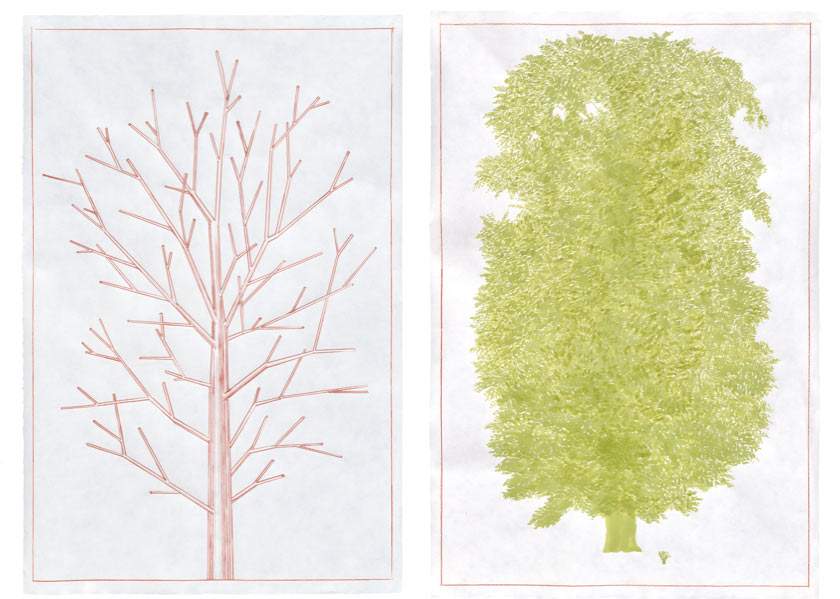Mestre, at the M9 Museum an exhibition on the history of Italy told with trees
An exhibition on the history of Italy told through trees, the testimonial value they hold and the emotional relationship these living beings have with people. It is about Trees! 30 Fragments of Italian History, the exhibition curated by landscape architect Annalisa Metta, arboriculturist Giovanni Morelli and popularizer Daniele Zovi, enhanced by the drawings of illustrator Guido Scarabottolo, organized and produced by M9 - Museo del ’900 in Mestre, and opening to the public from March 11 to August 10, 2022.
The exhibition, accompanied by a volume published by Marsilio Arte, uses trees to talk about the country’s histories through the gaze of these silent witnesses of the fragments that make up the multifaceted mosaic of Italy’s history, recent and past. Trees are part of our autobiography but also part of the lung of the earth; they know how to regenerate themselves, transforming the landscape where they have taken root. Along the 30 stages of the trail, visitors and readers will find shelter in the shade of specimens and species that are true wonders of nature, monumental trees that have populated our hills and mountains for centuries and sometimes even millennia.
It will therefore be a walk among surviving and survivor trees, among trees that do not want to know about dying and others that will never sprout, remaining forever the same as when they came out not from the earth, but from an assembly line. Trees that have always been on our peninsula and intruders in our landscape, coming from afar, recently or in very ancient times. From the boundless Ficus in Palermo to the upside-down Fig Tree of the Temple of Mercury in Baia, from the Poplar of the small Lombardy lookout to the only sequoia that survived the wave of the Vajont dam collapse, to the Botanically Correct Fake Tree, no longer the symbol of Christmas alone in the living rooms and modern dreams of Italians, but the silent spectator of all the public spaces we inhabit today.
The exhibition and volume consist of 30 original plates created for the exhibition by Guido Scarabottolo, one of Italy’s best-known illustrators, and 30 unpublished stories. To these is added a thirty-first story, by Daniele Zovi, dedicated to the Cansiglio forest and its beech trees in particular. One of these, felled by the storm Vaia, has found new life thanks to the work of artist Aron Demetz, who made from it the sculpture Untitled (2020), which depicts the forms of two lovers who seem to want life to continue beyond the present time. Aron Demetz, one of the great masters of contemporary wood carving, is an Italian artist who lives and works in Selva di Val Gardena, South Tyrol. He uses traditional woodcarving techniques but also a wide varietyÌ€ of other artistic processes to convey his concern for humanity’s relationship with nature.
“M9’s focus on environmental and landscape issues returns again in 2022, with a small tribute to the silent witnesses of the great and minimal events that make up Italy,” emphasizes Luca Molinari, scientific director of M9. “Along the furrow opened by the Foresta M9 installation that saw 600 tree essences populate the third floor of the museum, this year M9 once again welcomes spring with an exhibition in which trees are protagonists. It thus becomes a museum that breathes and is listening to the many fragments of history coming from people and communities.”
“What do trees say about us, here, now?” asks curator Annalisa Metta. “In common feeling today they are attributed a salvific destiny. However, precisely because they resemble us, they also express unresolved contradictions and ambiguities, urging us to reconsider many of the binary simplifications with which we pretend to govern ourselves and the world. Eleven of the trees in this exhibition manifest some form of anomaly or extravagance from the usual arboreal imagery. They are all variously disturbing and leave it up to us to consider whether to give credence to their/our stories and whether to feel comfort, amusement, pleasure or irredeemable annoyance from them.”
“Monumental trees are-just trees,” says curator Giovanni Morelli. “But the lives of these specimens end up containing those of many humans, the ultimate expression of the long-term coexistence between each monumental tree and its host community. Thus, beyond its unquestionable biological appeal, the monumental tree is such when it ceases to be a tree to become the tree, becoming symbol, narrative and testimony. There can be no monumental tree without memory, without narrative, and without context.”
For all information you can visit the M9 website.
Pictured are two plates by Guido Scarabottolo.
 |
| Mestre, at the M9 Museum an exhibition on the history of Italy told with trees |
Warning: the translation into English of the original Italian article was created using automatic tools. We undertake to review all articles, but we do not guarantee the total absence of inaccuracies in the translation due to the program. You can find the original by clicking on the ITA button. If you find any mistake,please contact us.




























